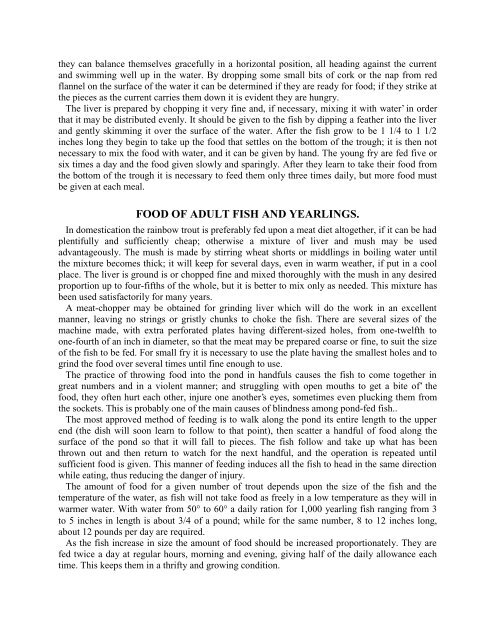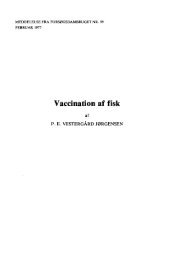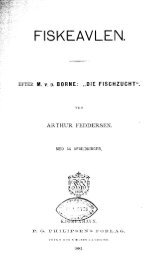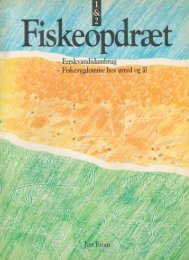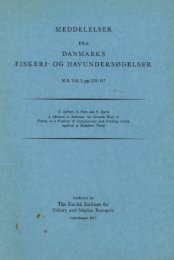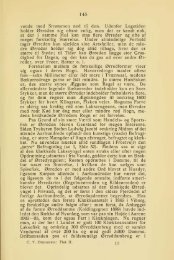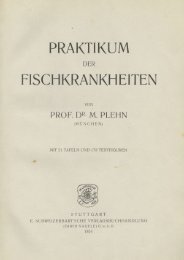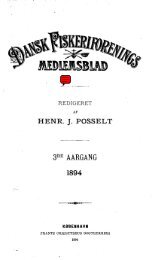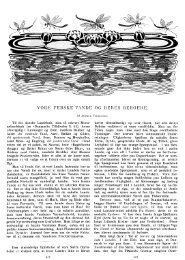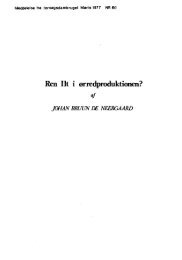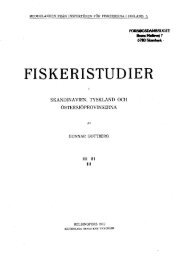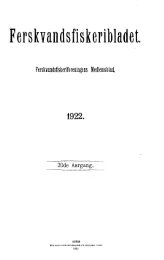You also want an ePaper? Increase the reach of your titles
YUMPU automatically turns print PDFs into web optimized ePapers that Google loves.
they can balance themselves gracefully in a horizontal position, all heading against the currentand swimming well up in the water. By dropping some small bits of cork or the nap from redflannel on the surface of the water it can be determined if they are ready for food; if they strike atthe pieces as the current carries them down it is evident they are hungry.<strong>The</strong> liver is prepared by chopping it very fine and, if necessary, mixing it with water’ in orderthat it may be distributed evenly. It should be given to the fish by dipping a feather into the liverand gently skimming it over the surface of the water. After the fish grow to be 1 1/4 to 1 1/2inches long they begin to take up the food that settles on the bottom of the trough; it is then notnecessary to mix the food with water, and it can be given by hand. <strong>The</strong> young fry are fed five orsix times a day and the food given slowly and sparingly. After they learn to take their food fromthe bottom of the trough it is necessary to feed them only three times daily, but more food mustbe given at each meal.FOOD OF ADULT FISH AND YEARLINGS.In domestication the rainbow trout is preferably fed upon a meat diet altogether, if it can be hadplentifully and sufficiently cheap; otherwise a mixture of liver and mush may be usedadvantageously. <strong>The</strong> mush is made by stirring wheat shorts or middlings in boiling water untilthe mixture becomes thick; it will keep for several days, even in warm weather, if put in a coolplace. <strong>The</strong> liver is ground is or chopped fine and mixed thoroughly with the mush in any desiredproportion up to four-fifths of the whole, but it is better to mix only as needed. This mixture hasbeen used satisfactorily for many years.A meat-chopper may be obtained for grinding liver which will do the work in an excellentmanner, leaving no strings or gristly chunks to choke the fish. <strong>The</strong>re are several sizes of themachine made, with extra perforated plates having different-sized holes, from one-twelfth toone-fourth of an inch in diameter, so that the meat may be prepared coarse or fine, to suit the sizeof the fish to be fed. For small fry it is necessary to use the plate having the smallest holes and togrind the food over several times until fine enough to use.<strong>The</strong> practice of throwing food into the pond in handfuls causes the fish to come together ingreat numbers and in a violent manner; and struggling with open mouths to get a bite of’ thefood, they often hurt each other, injure one another’s eyes, sometimes even plucking them fromthe sockets. This is probably one of the main causes of blindness among pond-fed fish..<strong>The</strong> most approved method of feeding is to walk along the pond its entire length to the upperend (the dish will soon learn to follow to that point), then scatter a handful of food along thesurface of the pond so that it will fall to pieces. <strong>The</strong> fish follow and take up what has beenthrown out and then return to watch for the next handful, and the operation is repeated untilsufficient food is given. This manner of feeding induces all the fish to head in the same directionwhile eating, thus reducing the danger of injury.<strong>The</strong> amount of food for a given number of trout depends upon the size of the fish and thetemperature of the water, as fish will not take food as freely in a low temperature as they will inwarmer water. With water from 50° to 60° a daily ration for 1,000 yearling fish ranging from 3to 5 inches in length is about 3/4 of a pound; while for the same number, 8 to 12 inches long,about 12 pounds per day are required.As the fish increase in size the amount of food should be increased proportionately. <strong>The</strong>y arefed twice a day at regular hours, morning and evening, giving half of the daily allowance eachtime. This keeps them in a thrifty and growing condition.


